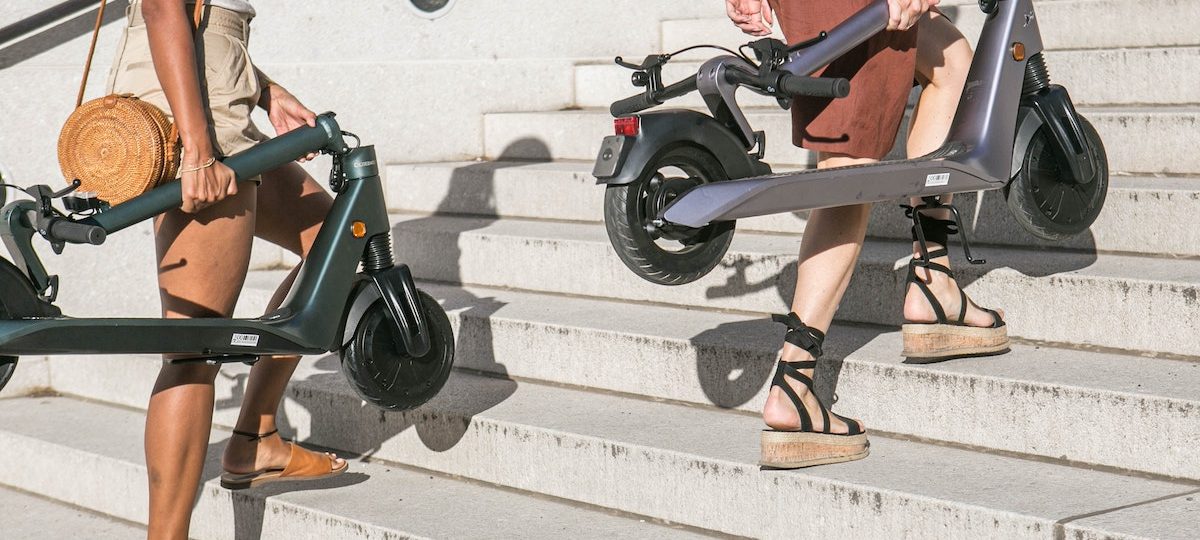The future of mobility is at a crossroads. In 2020, global auto sales hit 59.5 million units, marking a 20% decline from the previous year. Although the impact of the COVID-19 pandemic is undeniable, several mobility trends in recent years had already left the automobile industry fishtailing.
Growing environmental movements cast the spotlight on emissions concerns and electric vehicles. Meanwhile, digital disruption from ridesharing services has caused many consumers to question whether they need to own a car anymore.
This disruptive innovation is fueled by investors who remain undeterred by the industry’s struggles. TopTal reports mobility startups received over $115 billion of investment between 2010 and 2018, with 94% coming from outside the automotive industry.
While we can expect the auto sector to rebound in 2021, the bigger picture is less optimistic for OEMs—unless they embrace the latest innovations. Read on to learn about the critical mobility trends that are rapidly driving change in this industry as we hurtle towards a very different future of mobility.
Investment in Mobility is on the Rise
Computer software is an integral component of modern vehicles, which leads to more performance-efficient, durable machines. Consumers are more likely to hold on to a car for longer now because modern vehicles are more expensive to buy, and they’re also more robust and reliable.
The report from TopTal projects an 11% compound annual growth in vehicle software content, to the point that computer software will comprise 30% of the average vehicle value by 2030. However, the technology that enhances production and performance is a double-edged sword for OEMs because it is also the engine of disruptive innovation behind the recent slump in car sales.
Ridesharing apps go beyond the Uber concept, as venture capitals and private equity firms flock to the industry to back promising tech startups seeking to leverage high-potential mobility trends.
The shift is clear, as the average annual investment in e-hailing technology since 2014 has soared north of $11B—dwarfing the yearly average backing of $200M between 2010 and 2013.
Automotive leaders can’t survive the era of disruptive innovation by relying on traditional practices. Instead, OEMs must develop a business innovation strategy to focus on digital channels, establish recurring revenue streams, embrace zero-based budgeting, and build a more resilient supply chain.
The critical change, however, is to optimize asset deployment through strategic partnerships. Specifically, companies need to invest in autonomous technologies, connectivity, electrification, and shared mobility (ACES), as these four concepts are shaping the future of mobility.
6 Mobility Trends That Will Drive Future Automotive Innovation
Mobility is set to undergo incredible changes in the next decade. Here are the most crucial mobility trends that will steer the auto industry forward:
Government regulation will fuel Electric Vehicle (EV) innovation
Electric vehicles (EV) have been slow off the blocks, with public adoption of the concept idling for many years. But as automotive technologies evolve, the global share of EVs is bound to increase. It’s already happening, as Tesla is outselling BMW, Audi, and Mercedes in the U.S.

Image source: Ringo H.W. Chiu/Associated Press
Tesla is the most obvious success story in electric vehicles. Only founded in 2003, the company reached a market cap of $290B in July 2020, becoming the highest-valued automobile manufacturer in the world.
While its quest to produce more affordable electric vehicles continues, Tesla’s advances are buoyed by the open innovation across multiple verticals. By experimenting with businesses in solar power, solar roofs, and home batteries, the team has scaled its knowledge and resources, and ultimately, become a major societal influence on the future of mobility.
But the changing public perspective on electric cars isn’t just down to the influence of Elon Musk’s company. While modern EVs have a sleeker look and better performance, there is also more incentive to choose EVs over fossil fuel cars because of government regulations and grants.
Europe and China are leading a global environmental charge with strict targets for fuel economy and CO2 emissions. As the forces of governments and technology come together, EVs will soon become a more affordable, appealing option for more people, paving the way for global mass adoption.
Local governments across the US are key players in driving the adoption of EV innovation. For example, in Massachusetts transportation is a focus area for climate goals within the Commonwealth’s Decarbonization Roadmap to reducing greenhouse gas emissions by at least 85% by 2050 and achieving net-zero emissions. MassCEC, a Massachusetts state economic development agency for clean energy growth, offers programs and funding to the adoption of clean transportation initiatives across the state–awarding over $6 million in 43 awards to clean transportation projects.
Driving will become more autonomous
In 2018, when Uber’s prototype for a self-driving car killed a woman in Arizona, the concept of autonomous driving seemed like one of the most half-baked mobility trends that should have stayed in the movies. Even though it was deemed human error and not a technological flaw, the concept could easily have been buried under the weight of public backlash.
But the tragedy has not derailed the industry’s desire to bring automated driving into the mainstream, as 8 of the top 10 OEMs continue working on concepts for highly autonomous vehicles.

Unsurprisingly, safety is paramount for self-driving vehicles now, with guidelines from the Society of Automotive Engineers (SAE) clearly defining six levels of driving automation:
- Level 0 – No Automation: Zero autonomy. A human driver manually performs all tasks.
- Level 1 – Driver Assistance: A driver controls the vehicle, but the vehicle design may include some driving assistance features.
- Level 2 – Partial Automation: The vehicle has combined automated functions, like steering and acceleration. However, the driver must always remain engaged and must monitor the environment constantly.
- Level 3 – Conditional Automation: A driver is essential. They do not need to monitor the environment but must always be ready to assume control at any time.
- Level 4 – High Automation: The vehicle is capable of performing all driving functions under specified conditions. The driver has the option to take control.
- Level 5 – Full Automation: The vehicle is capable of performing all driving functions under all conditions. The driver may have the option to take control.
As the technology gets better and the safety elements improve, we can expect Level 4 autonomy to become widely available by 2023, with full adoption further down the track.
The most promising startups in the autonomous driving market include:
- Waymo – A subsidiary of Alphabet Inc. that offers a public ride-hailing service. The company is rolling out its driverless taxi service in the U.S.
- BrightWay Vision – An Israeli company that uses night-vision technology, gated sensors, cameras, and light sources to provide robust ADAS (Advanced Driver Assistance Systems) functionality.
- TriEye – Another Israeli startup that manufactures shortwave infrared cameras for autonomous vehicles, enabling enhanced monitoring of the environment in poor weather.

Source: McKinsey
Despite its setbacks, investors believe the fully autonomous car is one of the most bankable mobility trends for the future. When you consider that the public benefits of fully adopted autonomous vehicles could exceed $800 billion a year by 2030, the financial backing of the technology is easy to understand.
Companies will look to create new recurring revenue streams
As ridesharing and autonomous public transport grow in popularity, there will be greater opportunity for increasing revenue on an ongoing subscription basis, as shared vehicles will require more maintenance.
According to a McKinsey report on the future of mobility, OEMs will not rely so heavily on traditional vehicle sales. The report cites one example where $20B in sales accounts for less than half of the company valuation. Another $25B came from software subscription updates.
Recurring revenue streams have been steadily rising over the past decade, with a 50-fold increase between 2015 and 2017. And now, recurring revenue streams appear to have toppled the traditional sales model, with vehicle sales no longer the primary income generator for manufacturers.
Mobility-as-a-Service (MaaS) will continue to expand beyond car sharing
In the United States alone, McKinsey (again – they love mobility) reports that ridesharing is now a $30 billion market. While the pandemic has pumped the brakes on its meteoric growth, the industry is alive and well. There are currently over ten metropolitan areas generating north of $500 million in annual ridesharing revenues.
However, ridesharing apps like Uber are just one channel within the wider Mobility-as-a-Service (MaaS) model. A core principle of MaaS is to transform the dynamic of the traditional auto transport system. Instead of the vehicle-centric focus of years gone by, the future of mobility is consumer-centric.
MaaS platforms cover four key areas:
- Commercial use (e.g., CargoX)
- Software for personal use (e.g., Zipcar)
- Improvements to public transportation (e.g., Citymapper)
- Shared mobility services (e.g., BlaBlaCar)
MaaS companies have moved beyond the taxi industry into light vehicles, namely bikes and scooters. This emerging concept of “micro-mobility” is a direct response to growing consumer adoption, particularly in congested cities where people need faster methods of commuting.
The average personal vehicle remains parked and unused for most of the day. An e-bike or scooter is not only more mobile, but it helps consumers save on expenses like tax, insurance, vehicle maintenance, and parking.
Soon, users may be able to plan, book, and pay for journeys by all vehicle types through a single app. Whether you need an e-scooter or city taxi to get to work or a cross-country train to visit relatives, the expansion of MaaS will offer easier, more convenient travel for everyone.
Vehicle-to-Everything (V2X) will make driving safer
Vehicle-to-Everything (V2X) is a wireless technology that facilitates data exchange between a vehicle and its surrounding environment. Cars with V2X can wirelessly communicate with other vehicles and roadway infrastructure, and even with pedestrians if they’re on the same wireless network.
This technology is a significant advance on legacy sensors, enabling the vehicle to detect the movement of objects outside the normal field of vision offered by a traditional sensor. V2X communication systems offer drivers valuable updates on object positions and speed with real-time data sharing, constantly keeping them aware of potential risks.
Qualcomm is an American hardware company that creates digital wireless telecommunications products and services. It has a proprietary cellular vehicle-to-everything (C-V2X) technology that provides vehicles with 360° non-line-of-sight awareness. With this technology on board, it presents a much higher and more reliable level of predictability for autonomous driving.

Despite the apparent safety benefits, investment in V2X technology was initially slow to gain traction. Now, V2X is among the fastest-growing mobility trends, with the exponential growth expected to take the market value from $354M in 2019 to over $10.3B by 2027.
Last-mile innovations will be driven by greater e-commerce activity
Ecommerce grew by 46% in 2020, with lockdowns making a massive contribution, pushing consumers online to satisfy their shopping needs. Faced with the rising demand, ecommerce companies had to up their game by offering more choice and faster delivery.
As the new normal is an age where many companies can offer next-day delivery, it may surprise many people to learn that last-mile delivery is the most expensive and time-consuming stage of the shipping process. Regardless, companies must adapt and get quicker, as modern customers expect nothing less than speedy order fulfillment.
This growing reliance on ecommerce paves the way for further automation and digitization of supply chains. Without the most innovative technology, the future of mobility will struggle to keep pace with consumer demands and expectations for faster delivery.
And so, as autonomous-vehicle technology offers a solution for last-mile delivery challenges, new ecommerce companies will continue to flourish as brick-and-mortar stores struggle.
Benefits of ACES Innovation
The mobility trends above leave incumbents in the automobile industry facing a hard truth:
Digital disruption is inevitable. As tech startups continue experimenting with the latest technology, they receive increased backing from powerful investors.
So, rather than spinning their wheels with dated strategies, traditional OEMs must get involved with autonomous technologies, connectivity, electrification, and shared mobility.
Here are four benefits of investing in ACES innovation:
1. Safer commutes
With safety a top priority, the European mobility industry’s vision for 2050 targets a future of mobility with zero fatalities and accidents.
Despite the Uber accident, a 2019 Aces Survey found 45% of respondents trusted OEMs and authorities to make autonomous vehicles safe for public use.
As time goes on, shared, autonomous vehicles will become a safer, more reliable option in the years ahead, making them more appealing to women and families. ADAS systems, including automatic emergency braking, blind-spot monitoring, and adaptive cruise control, already exist, making roads safer and saving lives.
Furthermore, cost-effective design improvements will make vehicle interiors more comfortable and accessible for commuters, families, and seniors.
2. Less congestion
The pandemic hurt the micro-mobility market in a big way, as people are traveling less. More damaging was the growing trend of cities opening bike lanes. One company that operates a global network of e-bikes and e-scooters dropped 79% in valuation.
Nonetheless, the future looks bright for this type of transport, as it is an accessible form of transport, which is especially practical in crowded cities. For example, in peak tourist seasons, the medieval city centers in Europe are congested mazes of narrow streets.
With more investment in electric transport like e-scooters and e-bikes and greater connectivity through developing intercity bike lanes, cities can tackle congestion issues and optimize traffic flow.
3. Zero emissions
Since 1995, CO2 emissions from the automobile industry have plummeted almost 36%, mostly thanks to advances in engine efficiencies.
McKinsey’s vision for the future of mobility embraces all key objectives of the Paris Agreement and the 2030 agenda of the United Nations Environment Program. Through a focus on ACES, the auto sector can roll out green electricity for widespread suburban and rural transport applications.
Ultimately, mobility trends that encompass sustainable initiatives will make transport more convenient for consumers and less harmful to the environment. With a vision of emission-free cities, up to 30% of traffic space could be repurposed into livable spaces as the sector turns to ACES.
4. Lower mobility costs
With ACES technologies, the future of mobility will present more affordable transport options around the world. The falling cost of electric vehicles (EVs) will dramatically change the industry, encouraging mass consumer adoption of clean battery power vehicles.
Transportation costs are predicted to decrease by about 40% per km because of the rise of autonomous vehicles, while other mobility costs could fall to about 10 cents per km.
Before long, mobility will become more accessible to all demographics, giving teenagers, disabled people, seniors, and low-income families the chance to use convenient, environmentally-friendly transport services.
Final Thoughts
As demand for shared vehicles and public transport lulls in the wake of the pandemic, it offers false hope for OEMs. Innovation isn’t going anywhere as startups continue to pivot to new business models.
The latest mobility trends in autonomous technologies, connectivity, electrification, and shared mobility are not passing fads. Together, the ACES trends serve as the turbocharged engine transforming the auto industry at breakneck speed.
If your company wants to be part of the future of mobility, then it’s time to embrace open innovation with manufacturers, software companies, investors, and startup talent.










